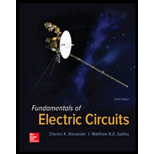
Concept explainers
Consider the single-phase three-wire system shown in Fig. 12.78. Find the current in the neutral wire and the complex power supplied by each source. Take Vs as a 220∠0°-V, 60-Hz source.

Figure 12.78
Calculate the complex power supplied by each source and the current passing through the neutral wire.
Answer to Problem 87CP
The current in the neutral wire is
Explanation of Solution
Given data:
Refer to Figure 12.78 in the textbook for a single phase three wire system.
The source voltage is
The supply frequency is
Formula used:
Write the expression to find the complex power
Here,
Write the expression to find the complex power
Here,
Write the expression to find the inductance reactance in ohms.
Here,
Write the expression to find the angular frequency.
Here,
Calculation:
Substitute
Substitute
Modify the given figure with the assumed current directions as shown in Figure.1.

Apply Kirchhoff’s voltage law to loop 1of current
Apply Kirchhoff’s voltage law to loop 2 of current
Apply Kirchhoff’s voltage law to loop 3 of current
Represent the equation (5) (6) and (7) in matrix form.
Obtain the value of determinants as follows.
Write the expression to find the currents,
Substitute
Substitute
Substitute
Substitute
Thus, the neutral current is
Substitute
Substitute
Conclusion:
Thus, the current in the neutral wire is
Want to see more full solutions like this?
Chapter 12 Solutions
Fundamentals of Electric Circuits
- Consider a three-phase Y-connected source feeding a balanced- load. The phasor sum of the line currents as well as the neutral current are always zero. (a) True (b) Falsearrow_forwardFigure 2.33 gives the general -Y transformation. (a) Show that the general transformation reduces to that given in Figure 2.16 for a balanced three-phase load. (b) Determine the impedances of the equivalent Y for the following impedances: ZAB=j10,ZBC=j20, and ZCA=j25. ZAB=ZAZB+ZBAC+ZCZAZCZA=ZABZCAZAB+ZBC+ZCAZBC=ZAZB+ZBAC+ZCZAZAZB=ZABZBCZAB+ZBC+ZCAZCA=ZAZB+ZBAC+ZCZAZBZA=ZCAZBCZAB+ZBC+ZCAarrow_forwardAn acb sequence balanced three-phase Y-connected source supplies power to a balanced, three-phase Δ-connected load with an impedance of 15 + 6i Ω/ϕ. The source voltage in the b-phase is 240∠−45∘ V. The line impedance is 1 + 1i Ω/ϕ. Use the single phase equivalent circuit for the a-phase to find the current in ampere in the a-phase of the load. Express your answer using polar notation, only provide the polar angle in degrees.arrow_forward
- A balanced delta connected load of 14+j16 ohm per phase is connected at the end of three phase line. The line impedance is 4+j6 per phase . The line is supplied from athree source with a line to line voltage of 207.85 Vrms. Tnaking phase voltage Va as reference determine the following: a) I in phase a b) Total complex power supplied from the source c) Magnitude of the line to line voltage at the load terminal.arrow_forwardThe following diagram shows a three-wire single-phase circuit of a house. Consider that the refrigerator consumes 8.5 A, with an inductive angle of 45°. TV and kitchen loads are 200W and 8kW respectively. Calculate: a) Current line 1, line 2 and neutral. b) Total power of the circuit....arrow_forwardAn acb sequence balanced three-phase Y-connected source supplies power to a balanced, three-phase Δ-connected load with an impedance of 12+j9 Ω/ϕ. The source voltage in the b-phase is 240 − 50 ∘ V. The line impedance is 1+j1 Ω/ϕ. Draw the single phase equivalent circuit for the a-phase and use it to find the current in the a-phase of the load.arrow_forward
- A balanced, positive-sequence, Y-connected voltage source with Eab = 480∠0o volts is applied to abalanced-∆ load with Z∆ = 30 ∠40o Ω. The line impedance between the source and load is ZL = 1 ∠850 Ω.for each phase. Calculate the line currents, the ∆ -load currents, and the voltages at the load terminals.Recall that ZY = Z∆/3arrow_forwardA balanced star-connected load having an impedance (15+j20) ohms per phase is connected to a three-phase, 440 V, 50 Hz supply. Find the line currents and the power absorbed by the load. Assume negative phase sequence.arrow_forwardAn acb sequence balanced three-phase Y-connected source supplies power to a balanced, three-phase Δ-connected load with an impedance of 15 + 6i Ω/ϕ. The source voltage in the b-phase is 240∠−45∘ V. The line impedance is 1 + 1i Ω/ϕ. Use the single phase equivalent circuit for the a-phase to find the current in ampere in the a-phase of the load. Express your answer using polar notation, only provide the polar magnitude.arrow_forward
- A certain generating plant in manila has 40kV, three phase transmission line to supply a 12MVA load at 30kV and 0.8 power factor. Find the resistance and reactance of the line if the length of the transmission line is 4,000 meters and the efficiency is 88%.arrow_forwardA d.c. 3-wire system is to be converted into a 3-phase, 4-wire system by adding a fourth wire equal in X-section to each outer of the d.c system. If the percentage power loss and voltage at the consumer's terminals are to be the same in the two cases, find the extra power at unity power factor that can be supplied by the a.c. system. Assume loads to be balanced.arrow_forwardProblem 2The following two three-phase loads are connected to a three-phase system of 311.13 cos (377 t) V line: 1) Three-phase induction motor of 10000 VA in Y with a power factor of 0.62) Three-phase load balanced in Δ with Zf = 20 ∠ 323.13 ° Ω. Please finda) total current in each line,b) the apparent and reactive power andc) the copper losses that occur.arrow_forward
 Power System Analysis and Design (MindTap Course ...Electrical EngineeringISBN:9781305632134Author:J. Duncan Glover, Thomas Overbye, Mulukutla S. SarmaPublisher:Cengage Learning
Power System Analysis and Design (MindTap Course ...Electrical EngineeringISBN:9781305632134Author:J. Duncan Glover, Thomas Overbye, Mulukutla S. SarmaPublisher:Cengage Learning
